This recipe yields a pan of buttery soft, gooey cinnamon sweet, and extra fluffy homemade cinnamon rolls topped with tangy cream cheese icing. It’s been a reader favorite recipe for years and I love it so much that I turned this rich dough into apple cinnamon rolls, pecan sticky buns, maple cinnamon rolls, and even a cinnamon roll wreath. You can make the cinnamon rolls within a few hours or get started the night before using the overnight preparation option.
This recipe is brought to you in partnership with Red Star Yeast.
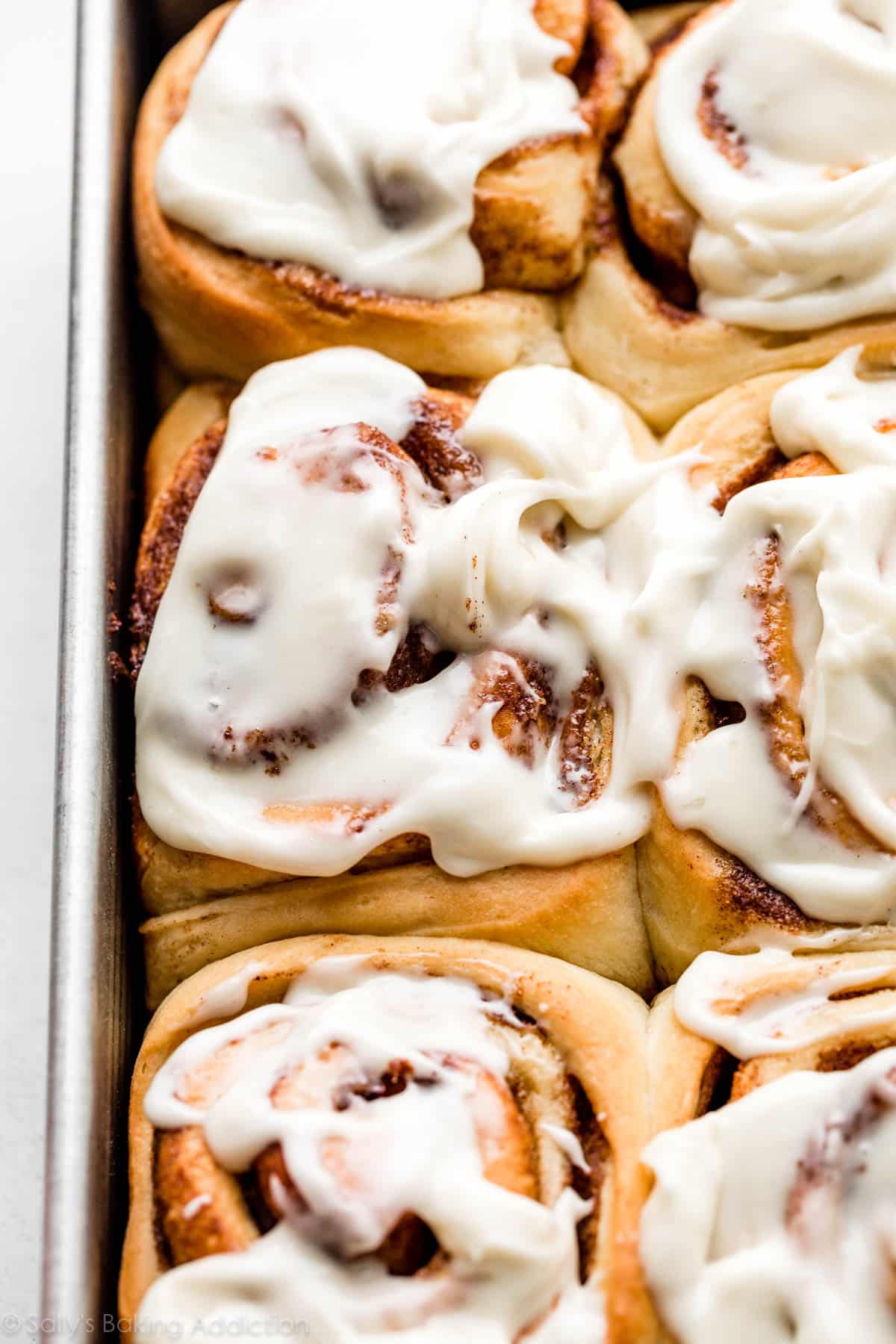
This cinnamon rolls recipe has lived on the site since 2014. After making countless more batches since I published the recipe plus answering readers’ comments and questions, I thought it would be beneficial to update the post with more helpful information and success tips. Homemade cinnamon rolls are a popular breakfast choice, so I want to make sure you have all the resources you need for this classic recipe.
By the way, if you love this dough, be sure to try it as raspberry sweet rolls or strawberry sweet rolls with lemon glaze next. Or for a sprinkle loaded treat, my birthday cake cinnamon rolls use the same dough, too!
Tell Me About These Homemade Overnight Cinnamon Rolls
- Texture: This is one of my richest homemade doughs, so you’re already promised a soft, springy, and fluffy texture. I usually use all-purpose flour, but if you use the optional bread flour, your rolls will be a little chewier. I find that these homemade cinnamon rolls are even fluffier than my easy 1 rise cinnamon rolls (and that’s because there’s the additional rise here!).
- Flavor: The smell of warm cinnamon rolls is oh-so-irresistible and inviting. Once you take that first bite, you’ll enjoy a fresh homemade dough that’s swirled with endless pockets of (Cinnabon style!) sweet and gooey cinnamon.
- Ease: Homemade dough and shaped breads require more precision and effort than making say, a coffee cake. But the dough is pretty straightforward and simple to shape, as long as you have enough flour nearby for your hands, work surface, and rolling pin.
- Time: This dough requires 2 rises. Once you understand the assembly process, the prep moves pretty quickly. Set aside at least 4-5 hours from start to finish or divide between 2 days with the overnight option. Whichever method you choose, keep in mind most of that time is hands off as the dough rises.
If you are craving cinnamon rolls right now, and just can’t wait for dough to rise, try these no yeast cinnamon rolls!
What Readers are Saying:
“I HAD to come and leave this rave review. I just baked and iced these cinnamon rolls ay 9:05 am. It’s now 10:55 am in a household of only 3 people only two are left. This recipe is the best I’ve ever tried. ★★★★★” – Chelsea
“Delicious and easy to follow! This was my first time cooking with yeast and my first time making homemade cinnamon rolls and this was a great recipe to start with. Everyone at brunch was blown away. ★★★★★” – Hannah
“Delicious! I have tried many cinnamon roll recipes, and this is my new favorite. I prefer a roll that is large, more fluffy than dense/gooey, and buttery without being overly sweet. This fit the bill! ★★★★★” – Brice
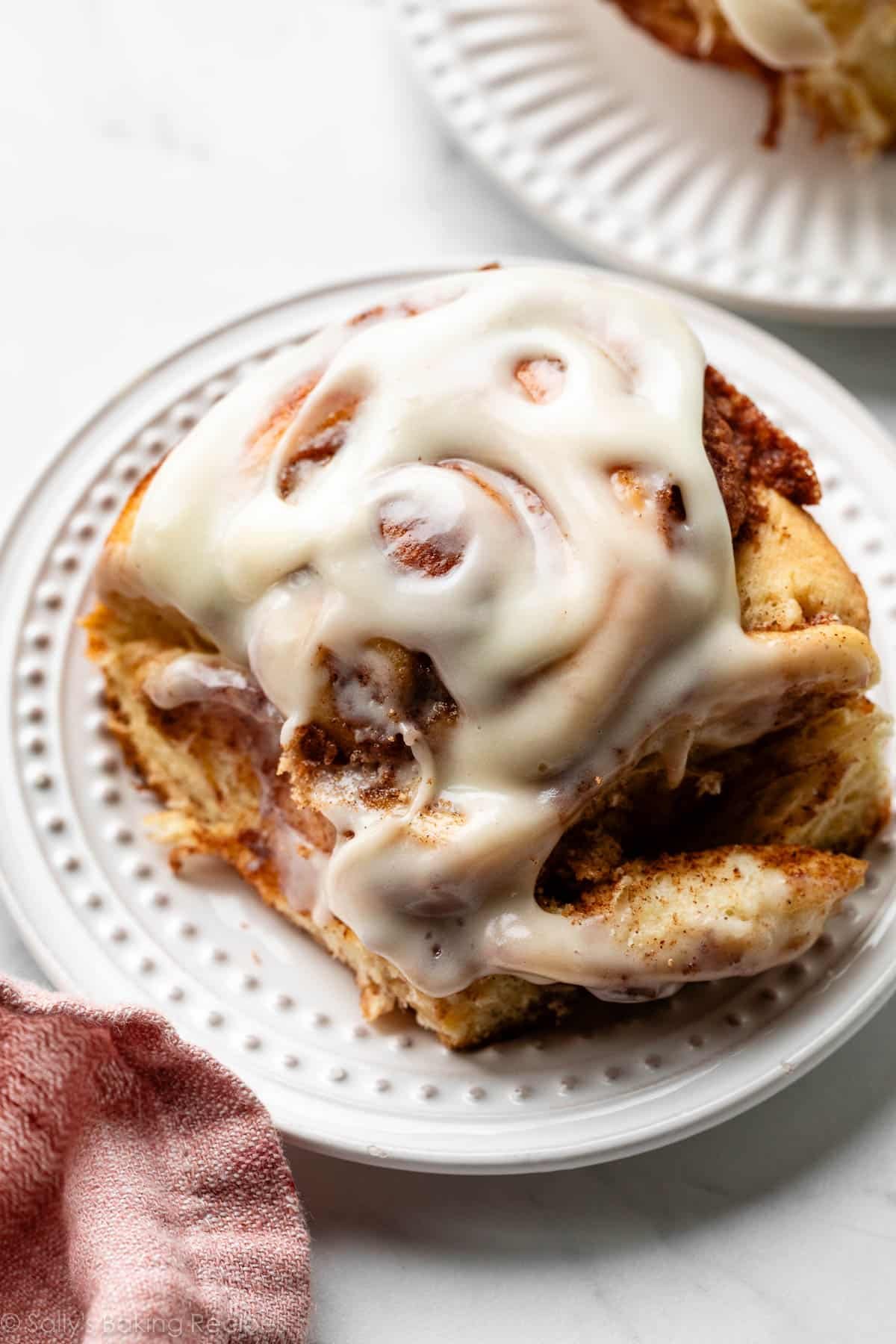
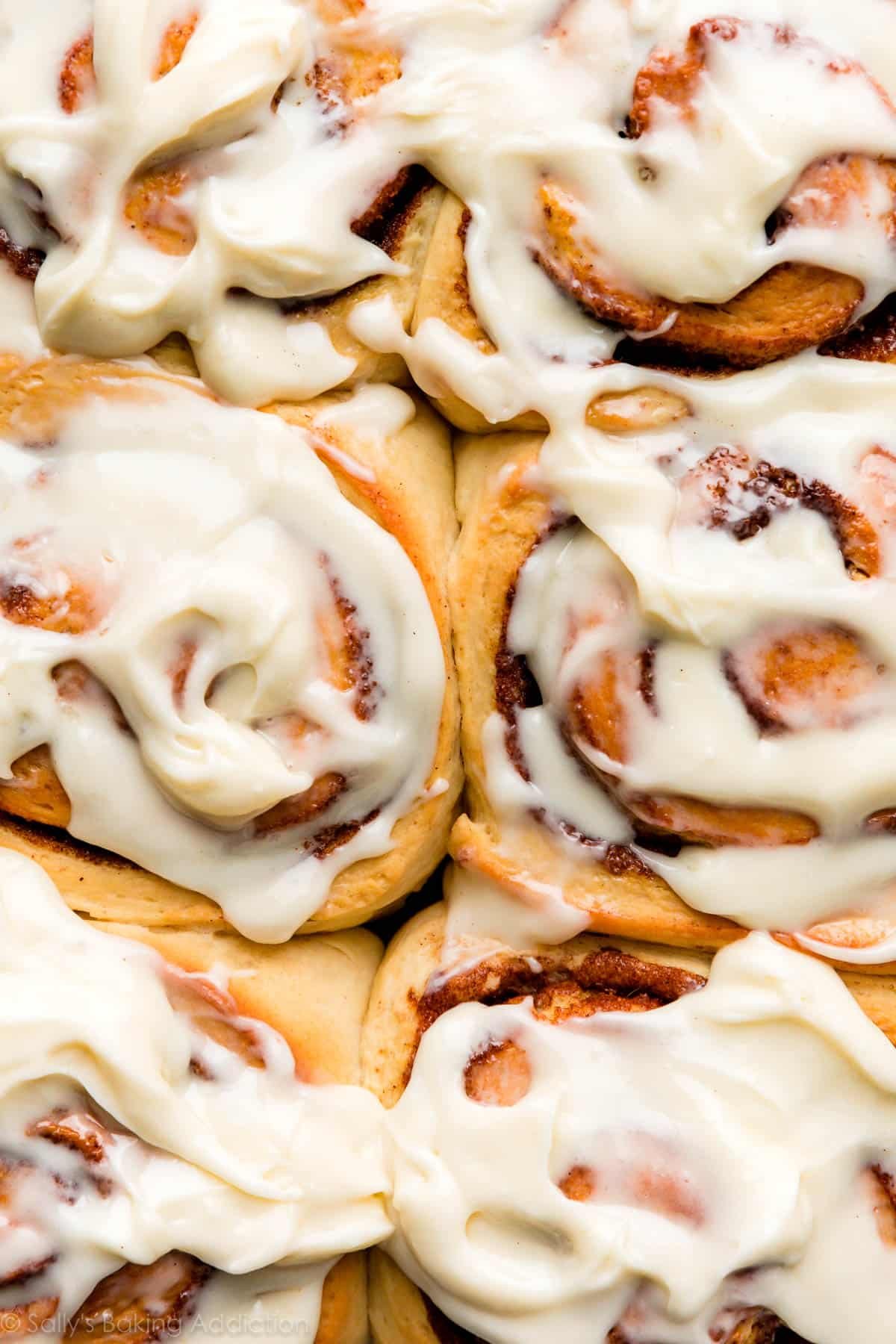
Are You a Yeast Beginner?
This Baking with Yeast Guide is a wonderful starting point for beginners. I answer many common yeast FAQs in easy-to-understand explanations, so you can learn the basics before beginning.
7 Crucial Ingredients in These Homemade Cinnamon Rolls
Feel free to skip straight to the recipe. But if you’re new to making bread, the following explanations are points that I’ve learned over the years and will be massively helpful.
- Whole milk: Whole milk is ideal for the richest tasting cinnamon rolls. Buttermilk works just as well without any changes to the recipe. Many readers have successfully substituted nondairy milks. In a pinch, you can use 2% or 1% milk, but do not use nonfat milk.
- Sugar: You need 2/3 cup of white granulated sugar in the dough. Use 2 Tablespoons in step 1 below (the proofing step), then add the rest in step 2.
- Yeast: You can use active dry or instant yeast. Follow the directions exactly as written regardless of which you choose. You’ll still proof the yeast in warm milk with some sugar even if you use instant yeast. This step ensures that the yeast is active and not expired. Most yeast these days is already active, but it’s a quick 5-10 minute step that prevents you from wasting your time just in case the yeast has expired. If using active dry yeast, the rise times will be a little longer. For the past 10+ years, my go-to brand has been Red Star Yeast. I always recommend Platinum Yeast from Red Star.
- Butter: This is a rich dough, meaning it has fat to help guarantee softness. Use 1/2 cup of softened butter and to help it blend easier, cut it into 4 pieces before adding.
- Eggs: Like butter, eggs promise a softer, richer dough.
- Salt: Dough is bland without salt.
- Flour: Flour is the structure of the dough. You can use either all-purpose flour or bread flour. You’ll notice the rolls are a little chewier if you use bread flour. It’s not a huge difference, so don’t worry if you only have all-purpose flour. (That’s what I usually use!)
Note: You’ll notice that I use more yeast in this recipe compared to my easy cinnamon rolls. Why? These are much fluffier and larger—about twice the size.
Step-by-Step Photos
Here’s what you’re looking for after you let the warm milk, some of the sugar, and yeast sit for about 5-10 minutes. The top will be a little foamy:
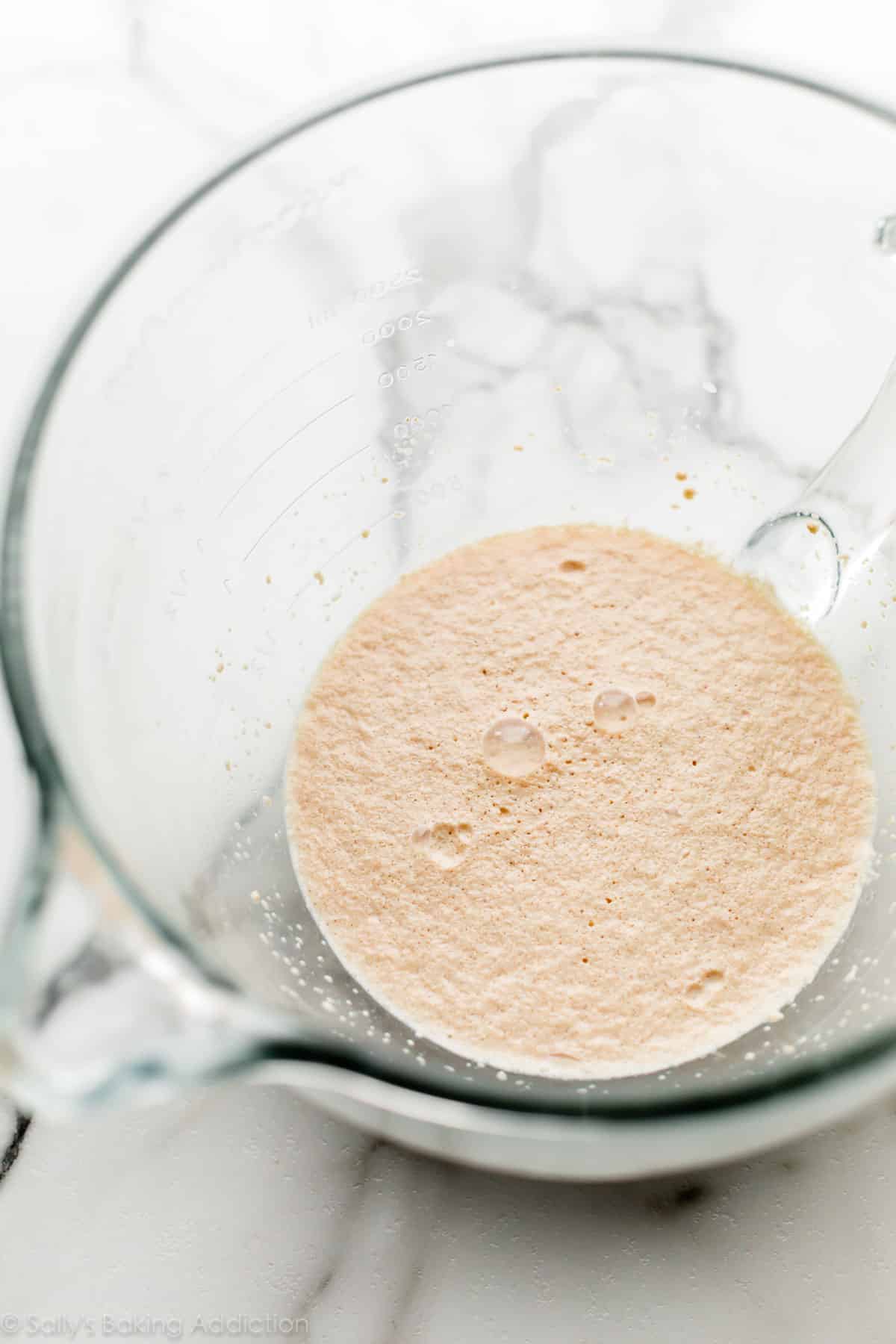
After the dough comes together, it will be a little soft and sticky—that’s normal. As explained in step 3 below, knead the dough on a floured counter or keep it in the mixer for kneading. If you’d like a visual of how to knead the dough by hand, you can watch the full video tutorial in my post on how to knead dough.
What If I Don’t Have a Stand Mixer? If you do not own a mixer, you can mix the dough together with a large wooden spoon/silicone spatula. It will take a bit of arm muscle. A hand mixer works, but the sticky dough repeatedly gets stuck in the beaters. Mixing by hand with a wooden spoon or silicone spatula is a better choice.
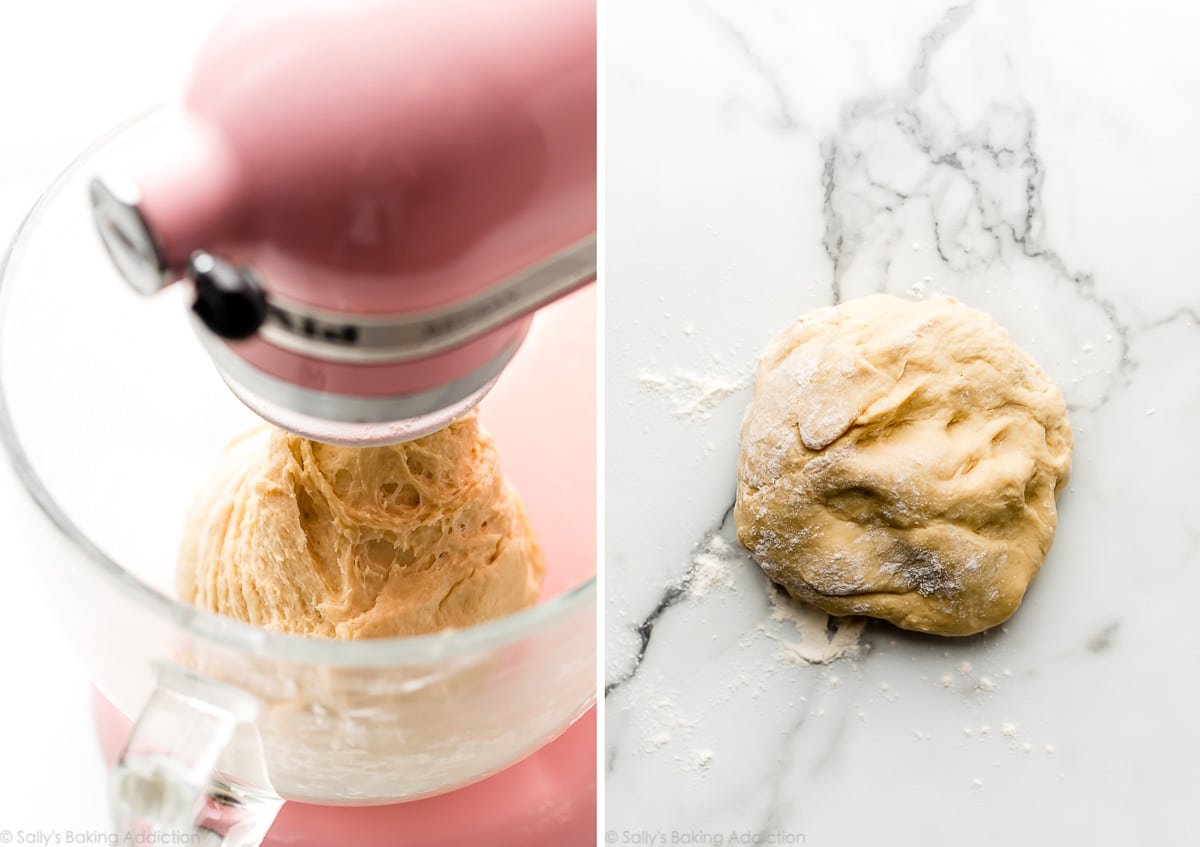
Let the dough rise until doubled in size:
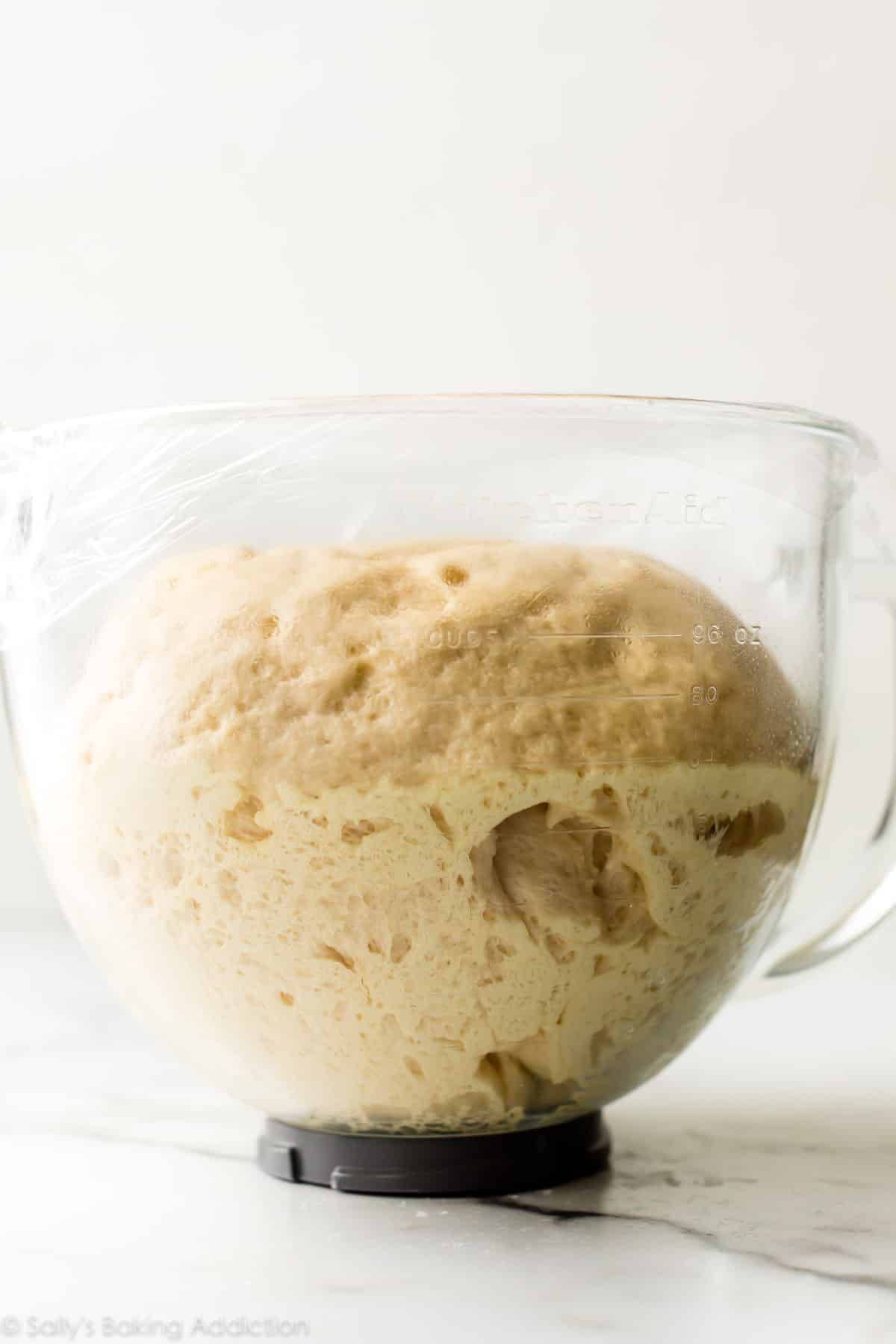
Punch the risen dough down and roll it out.
Baker’s Tip: If the dough keeps shrinking as you roll it out, stop what you’re doing, cover it lightly, and let it rest for 10 minutes to relax the gluten. When you return to the dough, it should stretch out much easier.
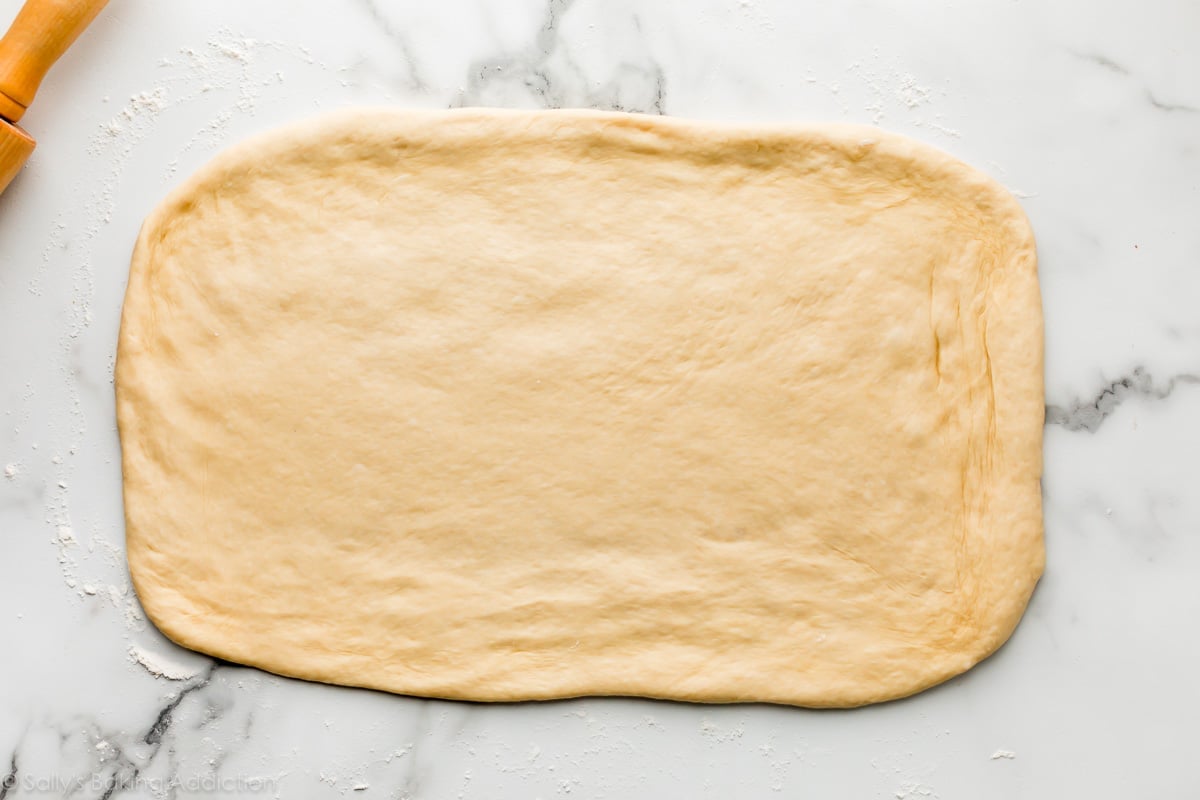
Spread softened butter on top, then sprinkle on a mixture of cinnamon and sugar (brown sugar or white granulated sugar).
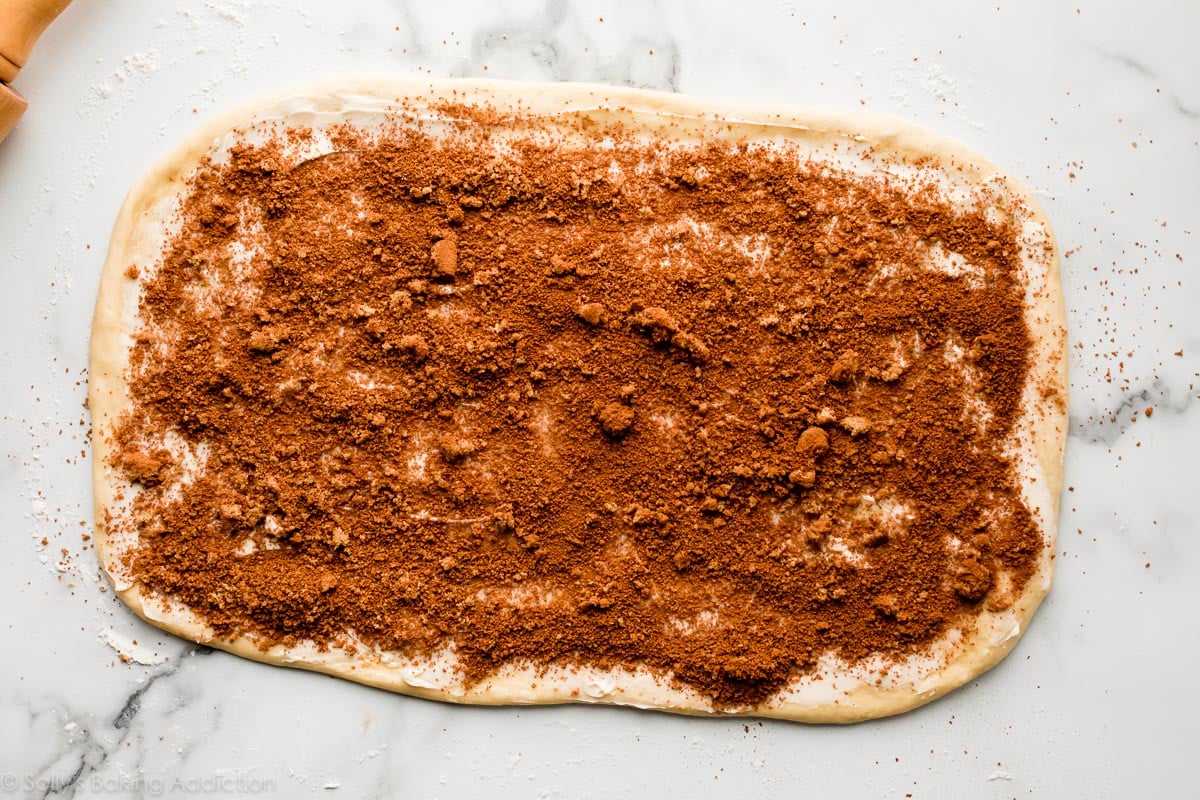
Roll it up:
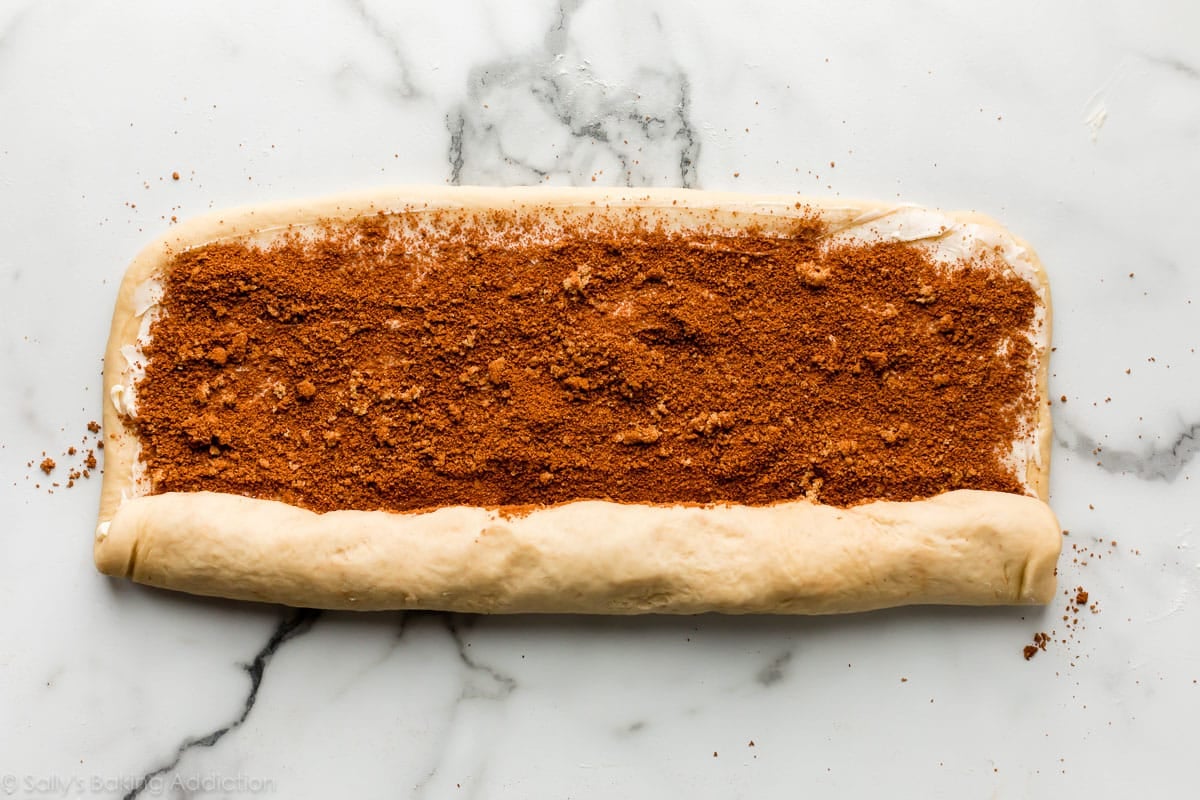
Use a very sharp knife to cut the roll into 12 rolls, each about 1.5 inches. Arrange in your greased baking pan, cover, then let the rolls rise until doubled in size and puffy, usually about 1 hour. The left photo is before rising and the right photo is after rising:
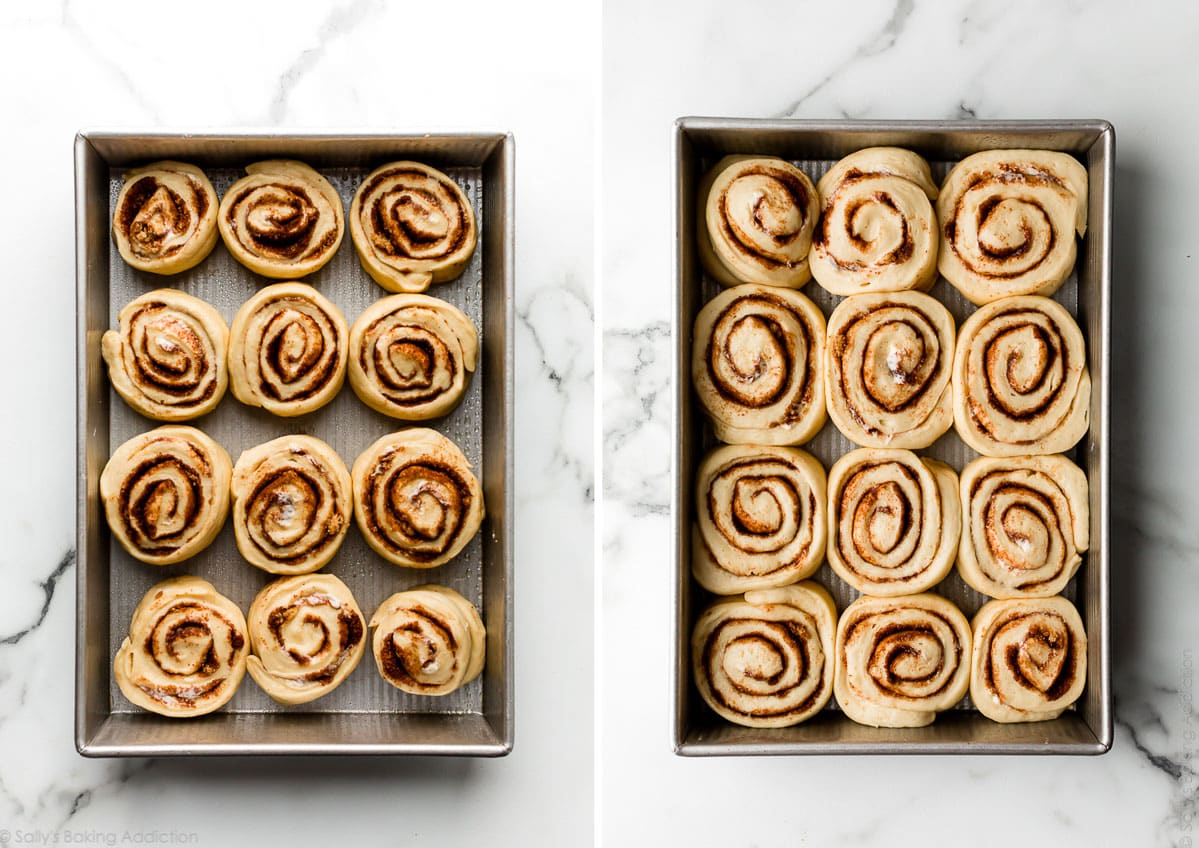
Bake the rolls and then make the tangy cream cheese icing to smother on top. If cream cheese isn’t your favorite, you could top the rolls with vanilla icing, the brown sugar icing from these pumpkin donuts, maple icing from maple cinnamon rolls, or even the caramel icing from apple cinnamon rolls. Lots of options!
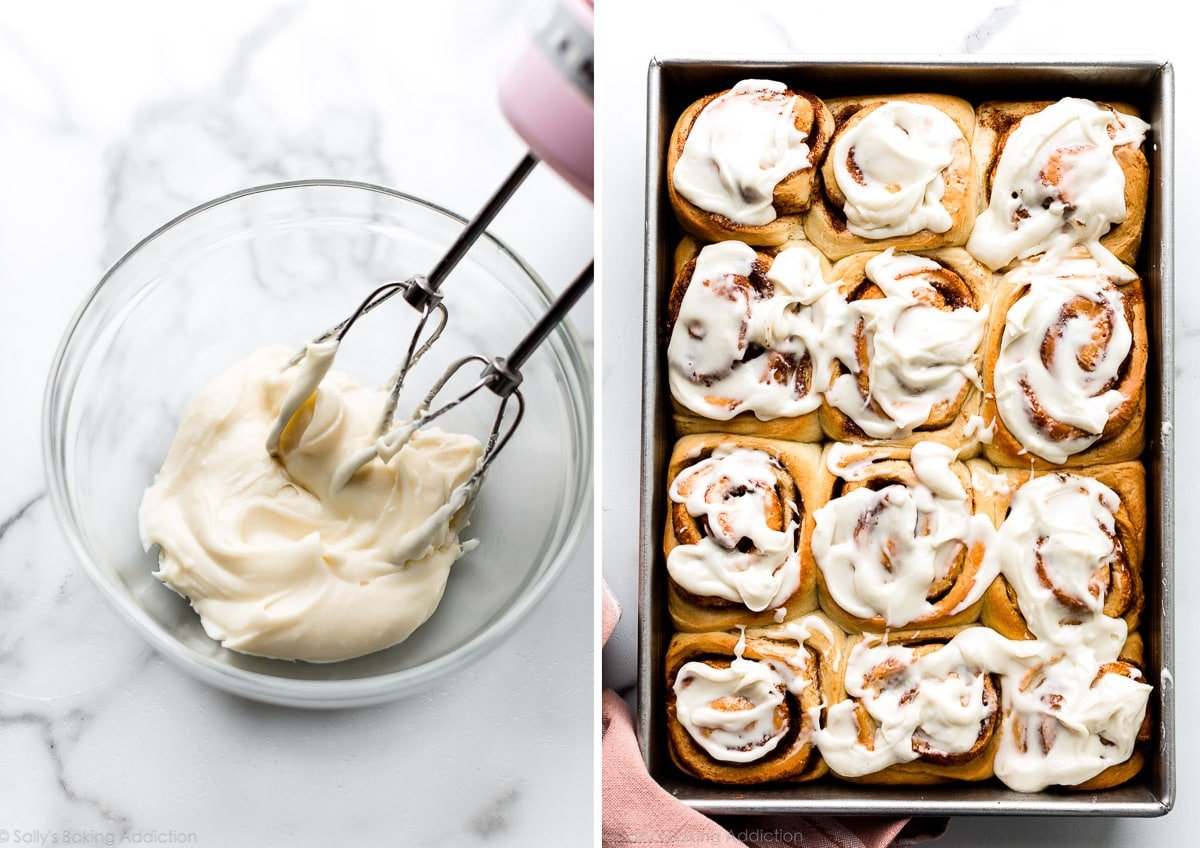
5 Success Tips
- Use brown sugar or granulated sugar in the filling: I used to use granulated sugar in the cinnamon sugar filling, but recently switched to brown sugar for extra flavor. Brown sugar doesn’t necessarily make the filling more moist—there’s so much butter, so it’s moist and gooey either way. Use whichever sugar you prefer.
- Best pan to use: I recommend a 9×13-inch glass pan or metal pan. Avoid ceramic pans. If you must use ceramic, keep in mind that the rolls will likely take longer to bake through.
- Evenly baked cinnamon rolls: These are extra big and fluffy cinnamon rolls, so to help guarantee the centers AND tops cook evenly, tent a piece of aluminum foil over the rolls after about 15 minutes in the oven. This will protect the tops from browning too quickly before the centers can cook.
- Don’t have all morning to spend on this dough? Feel free to prep the dough the night before. This is a wonderful way to save time in the morning so you can wake up and eat sooner. See my make-ahead/overnight instructions in the written recipe below.
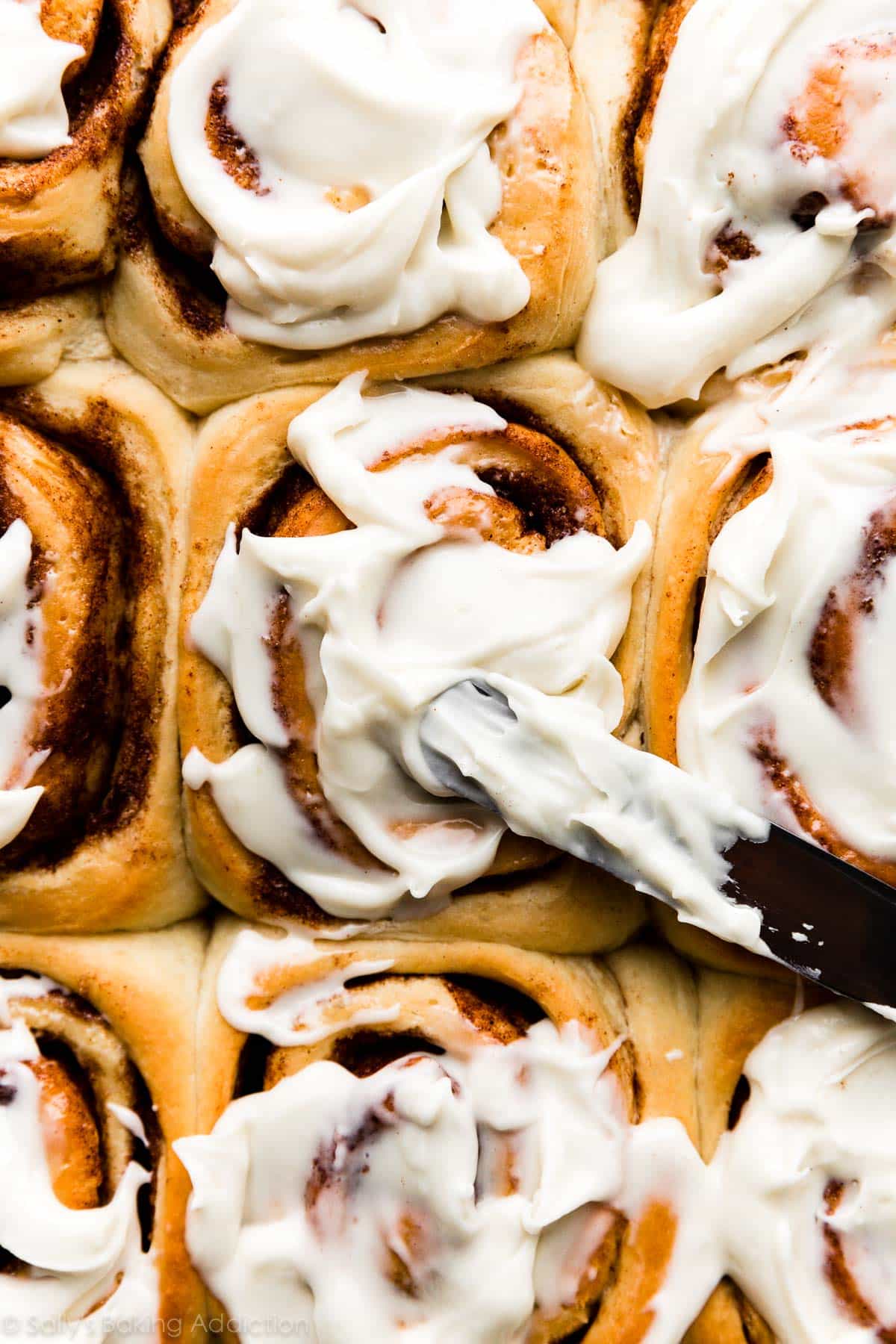
How to Freeze Homemade Cinnamon Rolls So They Still Taste Fresh
Let me share a tip I’ve learned after working with this dough for several years. You can prep the rolls and freeze them ahead of time so they still taste fresh.
- Here’s how: Bake the rolls in step 9 for only about 10 minutes. Cool completely, then cover and freeze. To serve, take the rolls out of the freezer and place in the refrigerator overnight to thaw. Once thawed, finish baking them for about 15-20 minutes.
I often use this method when I gift cinnamon rolls to others—just copy/paste or write these freezing instructions down. This method is also helpful if you have company over, want to cut down on time, or are entertaining. I like to make these cinnamon rolls ahead when I’m hosting holidays like Easter. See more Easter brunch recipes, like savory quiche and frittata, to complete your menu.
Print
Homemade Overnight Cinnamon Rolls
- Prep Time: 3 hours, 30 minutes (includes rises)
- Cook Time: 25 minutes
- Total Time: 4 hours (or overnight)
- Yield: 12 rolls
- Category: Breakfast
- Method: Baking
- Cuisine: American
Description
This recipe yields a pan of buttery soft, gooey cinnamon sweet, and extra fluffy homemade cinnamon rolls topped with tangy cream cheese icing. You can make the cinnamon rolls within a few hours or get started the night before using the overnight preparation option.
Ingredients
Dough
- 1 cup (240ml) whole milk, warmed to about 100°F (38°C)
- 2/3 cup (135g) granulated sugar, divided
- 1 and 1/2 Tablespoons (14g) active dry or instant yeast (2 standard size packets)*
- 1/2 cup (8 Tbsp; 113g) unsalted butter, softened to room temperature and cut into 4 pieces
- 2 large eggs, at room temperature
- 1/2 teaspoon salt
- 4 and 1/2 cups (563g) all-purpose flour or bread flour (spooned & leveled), plus more as needed
- 2 teaspoons canola, vegetable, or olive oil for bowl (or use nonstick spray)
Filling
- 1/2 cup (8 Tbsp; 113g) unsalted butter, softened to room temperature
- 2/3 cup (135g) packed light or dark brown sugar
- 1 and 1/2 Tablespoons ground cinnamon
Cream Cheese Icing
- 4 ounces (113g) full-fat brick cream cheese, softened to room temperature
- 1 cup (120g) confectioners’ sugar
- 1 Tablespoon (15ml) heavy cream or milk
- 1/2 teaspoon pure vanilla extract
Instructions
- Prepare the dough: Whisk the warm milk, 2 Tablespoons sugar, and the yeast together in the bowl of your stand mixer fitted with a dough hook or paddle attachment. Cover and allow mixture to sit for about 5 minutes or until foamy on top. *If you do not own a mixer, you can do this in a large mixing bowl and in the next step, mix the dough together with a large wooden spoon/silicone spatula. It will take a bit of arm muscle. A hand mixer works, but the sticky dough repeatedly gets stuck in the beaters. Mixing by hand with a wooden spoon or silicone spatula is a better choice.*
- On medium speed, beat in the remaining sugar (which should be 1/2 cup/100g) and the softened butter until it is slightly broken up. Add the eggs and salt and beat on medium speed until combined. The butter won’t really be mixing into the mixture, so don’t be alarmed if it stays in pieces. Switch the mixer down to low speed and with it running, add 1 cup of flour at a time, making sure it’s fully incorporated before adding the next. Stop the mixer and scrape down the sides of the bowl as needed. After 4 cups have been added, add the last 1/2 cup and beat until the dough comes together and pulls away from the sides of the bowl, about 3 minutes. Dough will be soft.
- Knead the dough: Keep the dough in the mixer (and switch to the dough hook if you used the paddle) and beat for an additional 5 full minutes, or knead by hand on a lightly floured surface for 5 full minutes. (If you’re new to bread-baking, my How to Knead Dough video tutorial can help here.) If the dough becomes too sticky during the kneading process, sprinkle 1 teaspoon of flour at a time on the dough or on the work surface/in the bowl to make a soft, slightly tacky dough. Do not add more flour than you need because you do not want a dry dough. After kneading, the dough should still feel a little soft. Poke it with your finger—if it slowly bounces back, your dough is ready to rise. You can also do a “windowpane test” to see if your dough has been kneaded long enough: tear off a small (roughly golfball-size) piece of dough and gently stretch it out until it’s thin enough for light to pass through it. Hold it up to a window or light. Does light pass through the stretched dough without the dough tearing first? If so, your dough has been kneaded long enough and is ready to rise. If not, keep kneading until it passes the windowpane test.
- 1st Rise: Lightly grease a large bowl with oil or use nonstick spray. Place the dough in the bowl, turning it to coat all sides in the oil. Cover the bowl with aluminum foil, plastic wrap, or a clean kitchen towel. Allow the dough to rise in a relatively warm environment for 2 hours or until double in size. (I always let it rise on the counter and it takes about 2 hours. For a tiny reduction in rise time, see my answer to Where Should Dough Rise? in my Baking with Yeast Guide.)
- Grease the bottom and sides of a metal or glass 9×13-inch baking dish (glass or metal) or line with parchment paper.
- Roll out the dough: Punch down the dough to release the air. Place dough on a lightly floured work surface and using a lightly floured rolling pin, roll dough into a 12×18-inch rectangle. Make sure the dough is smooth and evenly thick. If the dough keeps shrinking as you roll it out, stop what you’re doing, cover it lightly, and let it rest for 10 minutes to relax the gluten. When you return to the dough, it should stretch out much easier.
- For the filling: Spread the softened butter all over the dough. The softer the butter is, the easier it is to spread in this step. (Microwave it for a few seconds to soften if needed.) In a small bowl, mix the sugar and cinnamon together. Sprinkle evenly over the butter. Tightly roll up the dough to form an 18-inch-long log. If some filling spills out, sprinkle it on top of the roll. With an extra sharp knife, cut into 12 even rolls, about 1.5 inches each. Arrange in the prepared baking pan.
- 2nd Rise: Cover the rolls tightly and allow to rise until puffy, about 1 hour. (Or use the overnight option in the Notes below.)
- Preheat the oven to 350°F (177°C).
- Bake for about 25–28 minutes or until they are lightly browned on top. After about 15 minutes, tent a piece of aluminum foil over the top of the pan to prevent the tops from browning too quickly. Remove pan from the oven and place pan on a wire rack for about 10 minutes as you make the icing.
- Make the icing: In a medium bowl using a handheld or stand mixer fitted with a paddle or whisk attachment, beat the cream cheese on medium speed until smooth and creamy. Add the confectioners’ sugar, cream/milk, and vanilla. Beat on low speed for 30 seconds, then switch to high speed and beat for 1 minute. Spread the icing over the warm rolls and serve immediately.
- Cover leftover frosted or unfrosted rolls tightly and store at room temperature for up to 2 days or in the refrigerator for up to 5 days.
Notes
- Make Ahead Instructions – Overnight: To prepare the night before serving, prepare the rolls through step 7. Cover the rolls tightly and refrigerate for 8–12 hours. (16 hours max. 8–12 hours is best, but 16 hours is OK if absolutely needed. Do not exceed 16 hours.) The next morning, remove from the refrigerator and allow to rise on the counter for 1–2 hours before continuing with step 9.
- Make Ahead Instructions – Freezing: Baked rolls can be frozen for up to 3 months. Thaw overnight in the refrigerator and warm up before enjoying. You can also freeze the unbaked rolls and here’s how: bake the rolls in step 9 for only about 10 minutes. Cool completely, then cover tightly and freeze. To serve, take the rolls out of the freezer and place in the refrigerator overnight to thaw. Once thawed, finish baking them for about 15–20 minutes.
- Special Tools (affiliate links): Stand Mixer or Large Glass Mixing Bowl with Silicone Spatula or Wooden Spoon | Rolling Pin | 9×13-inch Glass Baking Pan or Metal Baking Pan | Cooling Rack
- Milk: I recommend using whole milk for the best, richest-tasting dough. You could also use buttermilk. Reduced-fat, low-fat, or nondairy milk works in a pinch. Do not use nonfat milk.
- Yeast: You can use active dry or instant yeast in this recipe. Follow all of the same instructions. If using active dry yeast, the rise times are usually slightly longer. Reference my Baking with Yeast Guide for answers to common yeast FAQs.
- Other Icing Options: Instead of cream cheese icing, you can top the warm rolls with vanilla icing, the brown sugar icing from these pumpkin donuts, maple icing from maple cinnamon rolls, or even the caramel icing from apple cinnamon rolls.
- Gluten Free: We have not tested this recipe with gluten-free flour, so we are unsure of the results.



















Great recipe, thank you!! My cinnamon rolls exploded out of the 9X13 pan. Do you think I over proofed them? I kneaded the dough for about 15 minutes and it still didn’t pass the window test…. I would love to try this recipe again and would appreciate any feedback. Thank you so much.
Hi Mercy! Yes, they could have been over-proofed, but if the texture was good, that may not have been the problem. Could your pan be slightly smaller than a 9×13? If you notice them getting unruly during baking, you can gently press them back into the pan with a spatula 🙂
THE BEST cinnamon rolls I’ve ever made. I’ll never use another recipe!
This is my go to cinnamon roll recipe. No fuss, no fail, and delicious. Thank you!
Can the cinnamon rolls be frozen after baking and frosted?
Hi Greg! Yes, cinnamon rolls can be frozen, but we recommend freezing without icing for best results. See recipe Notes for details!
Decent recipe, the rolls were indeed soft and delicious. My only gripe is that the dough has about twice the sugar it really needs—overall, the combo of filling, bread, & frosting made an extremely sweet combination that could use something else to balance it (and I have a HUGE sweet tooth!). Looking at other recipes with similar ingredients & quantities, it appears one could use just 1/3 cup of sugar in the dough without compromising textural results. But still good! Just sweeter than necessary for my taste with all the elements combined.
I love all of your recipes that I have tried – thank you so much! My daughter requested cinnamon rolls for her birthday dessert, and I’m struggling with the timing on a busy day. Do you think this would work if they are only in the fridge for 4-5 hours? Thanks for your help!
Yes, that would be fine. The refrigerator just slows down the rise, but the rolls have the chance to rise again when you remove them from the refrigerator.
My dough has risen a lot in the fridge overnight. Do I still need to let it sit on the counter for an hour or two before baking? I’m afraid it won’t stay in the pan!
For a short time period, yes. I would bring the rolls to close to room temperature before baking.
This is a truly wonderful recipe! I’ve made many cinnamon rolls, but this is the one I’ve stayed with for years.
HOWEVER, I live in the UK and this requires some adjustments. Firstly, moving from the States over 15 years ago, I’ve learned that the flour in the UK is far less absorbent and you need to either reduce your liquid or increase your flour or a combination. Following the recipe exactly, I had to add almost another 300g of flour to get a dough that was at all manageable, although still quite soft (a little wet even), as it should be. I suggest reducing your milk by 1/4c (60ml) and adding a little flour at at time until the dough is just manageable enough to knead.
Secondly, cream cheese icing IS A PROBLEM. I have yet to find block creamcheese here and the readily available spreadable makes a sloppy gelatinous mess. If you replace half the cream cheese with mascarpone you get a lovely silky and tangy icing. With the buttercream for the lemon blueberry layer cake or a carrot cake this will actually give you a beautifully pipable cream cheese frosting, something I thought impossible since I’ve been in the UK!
Hi! Do you think making the dough in a bread machine would work?
Hi Sabrina, We haven’t tested it in a bread machine ourselves, but we can’t see why not. Let us know how it goes!
This recipe is to die for. The dough is a dream. I doubled it, it still came out perfect. Pillowy, sift, not dry at all.
First attempt needs a lot more salt for my taste. I’m thinking salted butter might be the next experiment but I will try again because everything else was perfect!
Do you have nutrition facts for this recipe?
Hi Talia, We don’t usually include nutrition information as it can vary between different brands of the same ingredients. Plus, many recipes have ingredient substitutions or optional ingredients listed. However, there are many handy online calculators where you can plug in and customize your exact ingredients/brands. Readers have found this one especially helpful: https://www.verywellfit.com/recipe-nutrition-analyzer-4157076
This recipe is amazing. I’m making them again and wondering if I can make the frosting the night before as well? If so, any tips? Thank you! I love this site.
Hi Steph! Yes, you can make the frosting ahead, store covered in the fridge, then add to the cinnamon rolls when serving. It may thicken up a bit.
Why is the flour and salt measurements crossed out and thier boxes checked?
Hi Vallerie, the ingredients will show a strike through when clicked. This is a handy feature for readers to cross off which ingredients they have already used. Simply click it again and it the strike through will be removed. Hope this helps!
Came out perfect! Fluffy and indulgent.
Made this recipe for the first time, i wanted a simple and uncomplicated recipe for my first time making cinnamon rolls. They turned out great! My family LOVED them. I just have a question, can I add nuts and rains to my rolls, and do I need to adjust baking times at all? Just curious for further experimentation. Love Sally’s Baking Addiction for recipes! I’ve only just discovered the site, but every recipe I’ve tried has been a winner!
Thank you for trying our recipes! You can absolutely add nuts and raisins to the filling – sprinkle a handful over the cinnamon sugar before rolling them up.
ilove it so much
This recipe doesn’t say when to add the yeast mixture. This would be REALLY helpful.
Hi Makayla, After you let the yeast milk and sugar mixture rest for 5 minutes, you will add the other ingredients to that. It might also be helpful to watch the video on the page! Enjoy
Dear Sally, This was the best cinnamon roll recipe I have ever made. You mentioned in your Baking with Yeast Guide some tips that helped me so much. I have tried to make cinnamon rolls before and the dough has to much elastic to it and just tried to use it, and got very fustrated. Now I know what I can do if that happens again. My cinnamon rolls came out spectacular. I will only use your recipe from now on. Thank you for all your helpful hints.
Hi Laura, we’re so glad you found that helpful!
First time making cinnamon rolls last month using this recipe was a major success! 🙂 Because we’re a household of 2, I want to separate the rolls in smaller sizes so we can freeze and have fresh cinnamon rolls when the cravings come. Any suggestions on baking times?
Hi Ella, so glad you enjoyed the cinnamon rolls! We’re unsure of the exact bake time, but it should be just a bit shorter. Keep a close eye on them.
Best recipe ever!!!
When using the overnight method, do you leave them covered when you take them out the fridge for 2 hours?
Hi ER, Lightly or tightly covered is best. (Don’t keep them uncovered.)
Hello! What is the difference in the filling and icing between this recipe and https://sallysbakingaddiction.com/easy-cinnamon-rolls-from-scratch/#tasty-recipes-66508?
The quantity of ingredients in the filling is different, and so is the icing. In terms of icing, will one of the two set better?
Thank you
Hi Chiara! This Overnight rolls recipe makes a larger batch of cinnamon rolls. They both have a cream cheese icing that will set similarly.
Can i use something other than Brown sugar?
Hi Eliana! You can use brown sugar or granulated sugar in the filling.
Thank you!
My cousin & I are lifelong home bakers and we tried this recipe over the weekend and WOW, it is DELICIOUS! We added a little lemon zest in the frosting and it really elevated the flavor. We are at day 4 of the cinnamon rolls being in the fridge, and with a quick heat up, they are still as soft as the day we pulled them out of the oven. I am blown away, thank you always, Sally!
I made these cinnamom rolls and my family is begging for more! I wanna make a double batch. Do I have to use double the amount of yeast?
Hi Jazz! We always recommend making two separate batches instead of doubling for best results.
Hi Sally! Your blog/page is my new absolute go to for recipes! I have had so much success…until these cinnamon rolls 🙁 I am an experienced baker, mostly cakes and cookies, but I’ve made a couple of breads in the past. I had never tried rolls until yesterday, and I do not know where it went wrong. I followed the recipe to the letter, I used a stand mixer, and the dough was just NOT coming together on the dough hook like it should have. It was very tacky. I finally gave up and put it out on the board thinking kneading it by hand would do the trick. I prob added a total of a whole other cup of flour trying to knead it and get it to stick together. It sort of did, and it def more than doubled in size. But it definitely did not pass the window pane test. I was able to roll it out and make the rolls, and put them in the fridge overnight. This morning I took them out and they did not rise at all. I am waiting to bake them and hoping for a miracle. I live in FL and I saw another baker had the same issue and she said the end result was still fab, so I’m holding out hope! I used all fresh ingredients, new yeast, room temp everything. I am thinking maybe my mixer is too big for the recipe? I have a lift-up 7qt mixer…I’m not sure. Any ideas on what I could do better?? I will update with the end result…
Hi Lili, how did the rolls turn out? Somehow I missed your question last month. It sounds like the dough may have had too much flour added to it. If you try these again, try slightly reducing the liquid in the dough… I would try cutting 1 egg white (so use 1 whole egg and 1 egg yolk). That will help. I find that I don’t need to add as much extra flour when using the mixer to knead, so try keeping the dough in the mixer next time for that step. Also, keep in mind that the rolls will rise a bit more when you remove them from the refrigerator. Did yours?